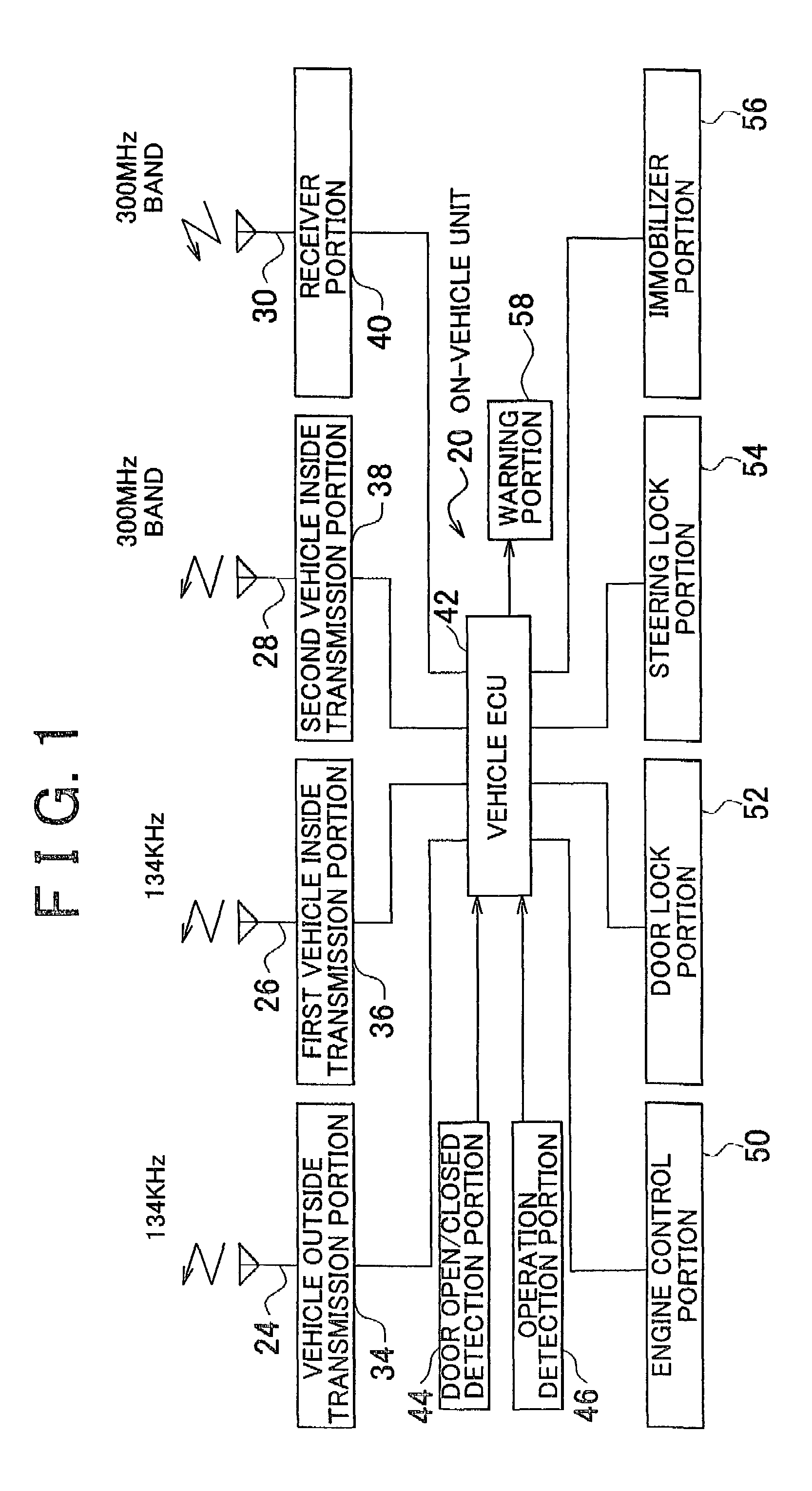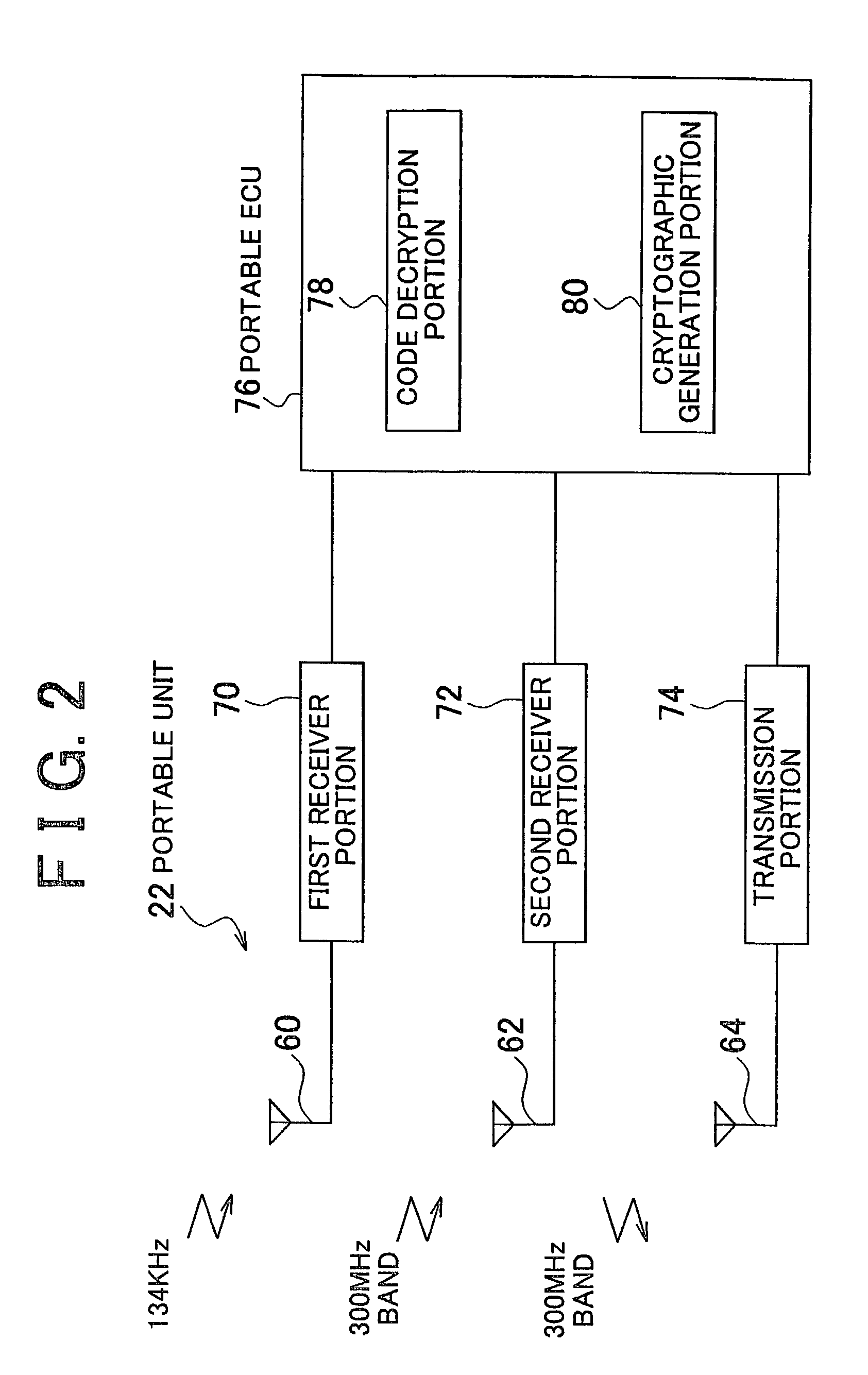Remote control system for on-vehicle equipment and remote control method for the same
a technology of remote control system and on-vehicle equipment, which is applied in the direction of process control, machine control, program control, etc., can solve the problems of inability to secure the communication area between the on-vehicle unit and the portable unit, the inability to lock or unlock the door or re-start the internal combustion engine, and the inability to secure the communication area. , to achieve the effect of suppressing the incidence of communication errors and stable communication area
- Summary
- Abstract
- Description
- Claims
- Application Information
AI Technical Summary
Benefits of technology
Problems solved by technology
Method used
Image
Examples
first embodiment
[0031]FIG. 1 is a view showing a configuration of an on-vehicle unit 20 provided in an on-vehicle equipment remote control system according to the invention. FIG. 2 is a view showing a configuration of a portable unit 22 provided in the on-vehicle equipment remote control system. The on-vehicle unit 20 is mounted into a vehicle. The on-vehicle unit 20 controls equipment (explained later) using wireless communication with the portable unit 22 that a vehicle operator carries, without involving an operation by the vehicle operator.
[0032]As FIG. 1 shows, the on-vehicle unit 20 has a vehicle outside transmission antenna 24, a first vehicle inside transmission antenna 26, a second vehicle inside transmission antenna 28 and a receiver antenna 30. The vehicle outside antenna 24 is provided, for example, on an outer handle of a manually operated vehicle door that is used when the vehicle operator enters, loads or unloads the vehicle. It has an effective communication area with a radius of, f...
second embodiment
[0073]Next, the invention will be explained with reference to FIG. 7 and the aforementioned FIGS. 1 and 2. A system according to this embodiment of the invention is realized through execution of a routine shown in FIG. 7 by the vehicle ECU 42 of the on-vehicle unit 20 in the configurations shown in FIGS. 1 and 2.
[0074]According to the first embodiment of the invention, the downlink communication from the on-vehicle unit 20 to the portable unit 22 that takes place on execution of the engine start control prior to the start of the engine utilizes only the low frequency radio wave (134 kHz). According to the second embodiment of the invention, the on-vehicle unit 20 is able to communicate utilizing both the comparatively low frequency radio wave (134 kHz) and the high frequency radio wave (300 MHz). Furthermore, taking into consideration that the portable unit 22 is able to receive both radio waves, the downlink communication utilizes both the low frequency radio wave and the high freq...
third embodiment
[0088]Next, the invention will be explained with reference to FIG. 8 and the aforementioned FIGS. 1, 2 and 7. A system according to this embodiment of the invention is realized through execution of a routine shown in FIG. 8 in place of the routine shown in FIG. 7 by the vehicle ECU 42 of the on-vehicle unit 20 in the configurations shown in FIGS. 1 and 2.
[0089]According to the second embodiment of the invention, unless the collation of the downlink communication that utilized the 134 kHz frequency radio wave is completed and, after that, the collation of the downlink communication that utilized the 300 MHz frequency radio wave is completed, then engine start is not permitted. According to the third embodiment of the invention, at the point when the collation of the downlink communication that utilized the 134 kHz frequency radio wave is completed, engine start is permitted and the collation of the downlink communication that utilized the 300 MHz frequency radio wave is carried out i...
PUM
 Login to View More
Login to View More Abstract
Description
Claims
Application Information
 Login to View More
Login to View More - R&D
- Intellectual Property
- Life Sciences
- Materials
- Tech Scout
- Unparalleled Data Quality
- Higher Quality Content
- 60% Fewer Hallucinations
Browse by: Latest US Patents, China's latest patents, Technical Efficacy Thesaurus, Application Domain, Technology Topic, Popular Technical Reports.
© 2025 PatSnap. All rights reserved.Legal|Privacy policy|Modern Slavery Act Transparency Statement|Sitemap|About US| Contact US: help@patsnap.com



